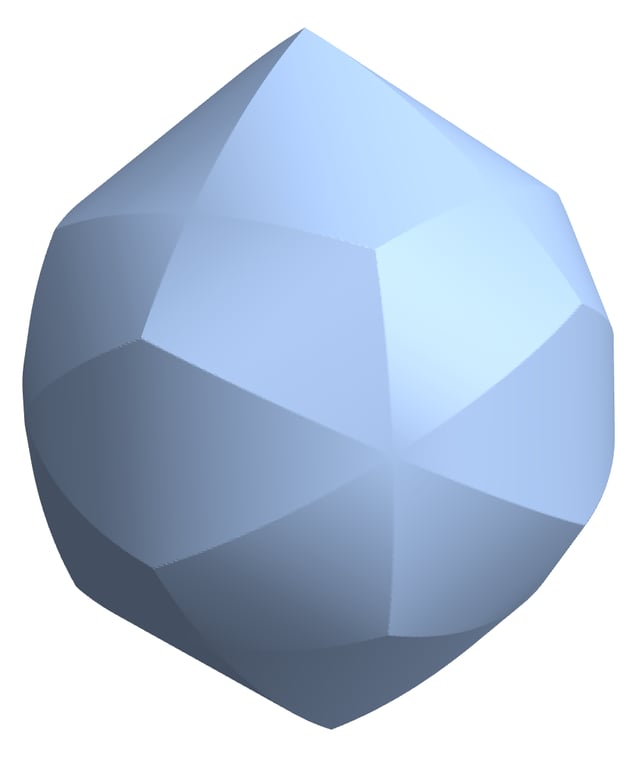Not an answer, but too long for a comment.
I don't know exactly about the details of the meshing algorithm that Mathematica uses. But I expect that it generates a region whose boundary vertices all lie on the true boundary surface (up to a very small error due to solving the boundary equations iteratively). As the body at hand is convex (it is the intersection of convex cylinders), and as all triangles/tetrahedra have their vertices inside the body (or on its boundary),
this would imply that the discretized body lies completely in the inside of the true body. Hence Mathematica's result for the volume should be lower than the true volume (plus some rounding errors).
Because 4.40045 is greater than 22/5 (and since I deem 0.00045 as too much for a rounding error), I would say that the 22/5 conjecture is not true.
Edit
When you use DiscretizeRegion and BoundaryDiscretizeRegion one should prescibe a maximal edge length of the generated tets and triangles. For example like this:
M = BoundaryDiscretizeRegion[reg, MaxCellMeasure -> (1 -> 0.01)];
Volume[M]
4.40038
If plot M and zoom-in, then you will see that the sharp edges of the body are cut off. Thus, the actual volume should be larger than 4.40038.
Edit 2
Here is a function that can be used to check whether a vertex lies within the body. It returns 1 if the 3-vector X lies inside and 0 otherwise.
cf = Compile[{{X, _Real, 1}},
Block[{x, y, z},
x = Compile`GetElement[X, 1];
y = Compile`GetElement[X, 2];
z = Compile`GetElement[X, 3];
Boole[
(0.3333333333333333` x + 0.6666666666666666` y -
0.3333333333333333` z)^2 + (0.6666666666666666` x +
0.3333333333333333` y +
0.3333333333333333` z)^2 + (0.3333333333333333` x -
0.3333333333333333` y + 0.6666666666666666` z)^2 <=
1.` && (0.6666666666666666` x - 0.3333333333333333` y -
0.3333333333333333` z)^2 + (-0.3333333333333333` x +
0.6666666666666666` y -
0.3333333333333333` z)^2 + (-0.3333333333333333` x -
0.3333333333333333` y + 0.6666666666666666` z)^2 <=
1.` && (0.6666666666666666` x + 0.3333333333333333` y -
0.3333333333333333` z)^2 + (0.3333333333333333` x +
0.6666666666666666` y +
0.3333333333333333` z)^2 + (-0.3333333333333333` x +
0.3333333333333333` y + 0.6666666666666666` z)^2 <=
1.` && (0.6666666666666666` x - 0.3333333333333333` y +
0.3333333333333333` z)^2 + (-0.3333333333333333` x +
0.6666666666666666` y +
0.3333333333333333` z)^2 + (0.3333333333333333` x +
0.3333333333333333` y + 0.6666666666666666` z)^2 <= 1.` &&
x^2 + y^2 <= 1.`
]
],
CompilationTarget -> "C",
RuntimeAttributes -> {Listable},
Parallelization -> True
];
If I apply this to the mesh M from above then I get
b = cf[MeshCoordinates[M]];
Count[b, 0]
Count[b, 1]
109
399393
So the vast majority of points lies inside. But few of them loe outside. I guess they deviate so little that this would not matter. Maybe one can move them just a little inside? For simplicity, I just move all the points of the discrete region a little bit towards the origin:
Mscaled = TransformedRegion[M, {x, y, z} |-> 0.99999999 {x, y, z}];
Count[cf[MeshCoordinates[Mscaled]], 0]
Volume[Mscaled]
0
4.40038
So now all of the discrete regions vertices lies within the convex body, but the volume enclosed by the mesh is still greater than 22/5.
Edit 3
By the way, in order to have at least on higher resolution picture of the body:

